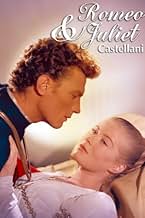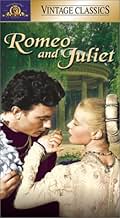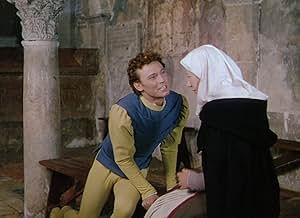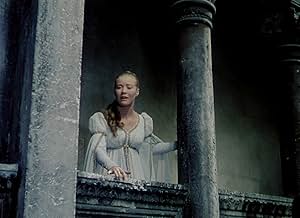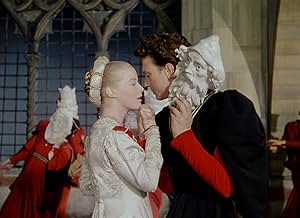अपनी भाषा में प्लॉट जोड़ेंIn Shakespeare's classic play, the Montagues and Capulets, two families of Renaissance Italy, have hated each other for years, but the son of one family and the daughter of the other fall de... सभी पढ़ेंIn Shakespeare's classic play, the Montagues and Capulets, two families of Renaissance Italy, have hated each other for years, but the son of one family and the daughter of the other fall desperately in love and secretly marry.In Shakespeare's classic play, the Montagues and Capulets, two families of Renaissance Italy, have hated each other for years, but the son of one family and the daughter of the other fall desperately in love and secretly marry.
- निर्देशक
- लेखक
- स्टार
- 3 BAFTA अवार्ड के लिए नामांकित
- 6 जीत और कुल 6 नामांकन
Ennio Flaiano
- Prince of Verona
- (as Giovanni Rota)
Thomas Nicholls
- Brother Giovanni
- (as Tom Nicholls)
फ़ीचर्ड समीक्षाएं
This film version created by Renato Castellani is a beauty to behold.
In the picturesque settings of Siena, Padova, Verona and Venice, this romantic tale unfolds in glorious color.
While the character interpretations may appeal to a select number, I appreciate the total concept and the carrying out of that objective.
"Romeo" takes on a stylistic life of its own through Castellani, and for those willing to go on his journey, the rewards are great.
Mr. Harvey is interesting to see in an early role. As always, his work is very well thought out, and the aloofness which made him so right for callous young men in later modern roles, is intriguing here. Romeo now has a tinge of egotism and even femininity.
Well, why not? As there are dozens of ways to read a line, so there are many approaches to a character. There's nothing inherently sacrosanct in the role of Romeo, and Harvey interprets the way he (and Castellani) sees him, rather than according to some staid traditional model.
It's hard to believe this lovely production has not yet been transferred to video. Surely one day some enterprising company will take on this project and help preserve a very beautiful production for future generations to enjoy.
In the picturesque settings of Siena, Padova, Verona and Venice, this romantic tale unfolds in glorious color.
While the character interpretations may appeal to a select number, I appreciate the total concept and the carrying out of that objective.
"Romeo" takes on a stylistic life of its own through Castellani, and for those willing to go on his journey, the rewards are great.
Mr. Harvey is interesting to see in an early role. As always, his work is very well thought out, and the aloofness which made him so right for callous young men in later modern roles, is intriguing here. Romeo now has a tinge of egotism and even femininity.
Well, why not? As there are dozens of ways to read a line, so there are many approaches to a character. There's nothing inherently sacrosanct in the role of Romeo, and Harvey interprets the way he (and Castellani) sees him, rather than according to some staid traditional model.
It's hard to believe this lovely production has not yet been transferred to video. Surely one day some enterprising company will take on this project and help preserve a very beautiful production for future generations to enjoy.
Yes, this film has been overpraised by Pauline Kael and others. For its time it was revolutionary, because no previous Shakespeare film had used so many outdoor, realistic locations. Unlike the previous MGM version (which all in all is superior), this version did not use middle-aged actors and made splendid use of technicolor. Black and white cinematography may suit MACBETH, HAMLET, KING LEAR, and other Shakespeare trajedies--but not this one. Since 1954, however, it has been remade in more cinematic and dynamic versions.
Nonetheless, it's a very worthwhile movie, especially for Shakespeare fans. I personally think Laurence Harvey is a terrific Romeo. Yes, he's a bit of a simp, but that's the character. In fact, Harvey is the screen's best Romeo; he's a lot more passionate than Leslie Howard in the MGM version, and he speaks the verse better than either DiCaprio or Leonard Whitting in the two subsequent versions. The locations, better than any version, remind us of just how thin the streets were in Verona during the time of the play, and the high, thick, stone walls serve as a symbol of the intransigence of the families.
Yes, it does have shortcomings, but don't dismiss its virtues, which are many, especially to those of us who want more than the MTV-type Shakespeare that the DiCaprio version offers.
Nonetheless, it's a very worthwhile movie, especially for Shakespeare fans. I personally think Laurence Harvey is a terrific Romeo. Yes, he's a bit of a simp, but that's the character. In fact, Harvey is the screen's best Romeo; he's a lot more passionate than Leslie Howard in the MGM version, and he speaks the verse better than either DiCaprio or Leonard Whitting in the two subsequent versions. The locations, better than any version, remind us of just how thin the streets were in Verona during the time of the play, and the high, thick, stone walls serve as a symbol of the intransigence of the families.
Yes, it does have shortcomings, but don't dismiss its virtues, which are many, especially to those of us who want more than the MTV-type Shakespeare that the DiCaprio version offers.
There are certain indispensable elements for a great Romeo and Juliet: youthful, energetic lovers; a brilliant Mercutio and irrepressible Nurse; and crisp pacing. Castellani's version fails on all counts. Take pacing. This is a tragedy of timing; the story unfolds over 4 days of desperate urgency. Yet Castellani's screenplay DRRRAAGGSS, interrupting key scenes with tedious stage business. Take the opening brawl: instead of escalating rapidly, it *stops* while the Capulets lug home the body of a servant, women wail, etc. Who cares about the servant? When do we get to the real action? Similarly, when Romeo opens the tomb, Castellani has him stop, walk all the way back outside, find an appropriate tool, and then start over. What a waste of screen time! It's dismaying that these unnecessary scenes are added at the expense of some of the play's best material. A high point in most productions is Mercutio's Queen Mab speech yet Castellani omits it! All directors make cuts, but why this key speech? Castellani seems to think little of Shakespeare's language, preferring his own dialogue. That's right; he cuts Queen Mab but adds vapid filler for Rosaline and other minor characters. Did he really think no one would notice? As for the actors, Susan Shentall sleep-walks through most of her scenes, but after two hours of Lawrence Harvey's plodding monotone, I can't blame her. These actors can't even summon the energy for a proper swordfight; Tybalt merely stabs Mercutio, while a bored looking Romeo bashes Paris over the head. Where's Basil Rathbone when you need him?
This production is often praised for its lush costumes, picturesque Italian locations and cinematography reminiscent of Italian paintings. It's pretty as a picture, but equally lifeless.
This production is often praised for its lush costumes, picturesque Italian locations and cinematography reminiscent of Italian paintings. It's pretty as a picture, but equally lifeless.
Handsome, leisurely-paced, ineptly cut, often badly acted (especially by Laurence Harvey as Romeo, surprisingly) version of Shakespeare's most playful and youthful tragedy. Much of the film's charm lies in the creation of sumptuous tableaux in the tradition of Italian Renaissance painting, and the portrayal of Capulet is a marvelously acted stereotype of the fat, crude nouveau riche Italian patriarch; but Harvey (despite a few promising moments early on) is far too effusive and unctuous, creepily reminiscent of John Dall in Rope; Susan Shentall displays admirable coyness and gusto in the "overture" of the dance and courtship scenes, but stiffens and is stifled by the death of a thousand cuts toward the end (although almost nothing is cut from the first act). Still, aside from some ghastly, somnambulistic line readings, the film often dazzles with its feeling for the music of Shakespeare's text; the Nurse's folkloric shanty is highlighted with musical settings (shadings)-- Flora Robson is delightful in the role; the vaguely rappish banter of Benvolio and Romeo's first scene is gracefully and intelligently played. The presentation of the episode of losing the letter due to the Plague is a brilliant use of cinema to bring out embedded narrative in Shakespeare. The near-interchangeability of the actors who play Benvolio, Tybalt and Paris is regrettable.
Of the several different cinematic adaptations of ROMEO & JULIET that are out there, this version has always been my personal favorite since I first saw it in the early 1970s. The Franco Zefferelli production has that distinction but if you've never seen this one, then you should definitely give it a try now that VCI has given us such a gorgeous looking anamorphic transfer. For years I have had the old MGM VHS tape which I will now gladly donate to the local thrift store where there are still customers who use VHS. There's no need to go into the story since everyone knows that, so I'll focus on what it is about this particular adaptation that I enjoy so much.
First are the locations. The film was shot on location in Verona and other Italian cities in such a way as to resemble Renaissance paintings thanks to the skill of legendary cinematographer Robert Krasker (THE THIRD MAN) who shows here that he can use color the way he used black and white in that classic film. Second is the score by Roman Vlad which is written in the style of music of the period. A galliard which serves as a motif throughout the movie is memorable and effective. Last but not least are the performances. Laurence Harvey, 26 at the time, gives the best line readings of any screen Romeo I have ever heard. Some find his Romeo too effiminate but that will always be a matter of personal opinion. Susan Shentall is not the ideal Juliet but she is more than adequate and her death scene manages to be quite moving. Add character players Flora Robson, Bill Travers, Mervyn Johns and Sebastian Cabot to the mix and their characters spring to life.
Italian director Renato Castellani creates an ideal balance in his movie with a theatrical staging that flows cinematically. The style of dialogue delivery is old school Shakespeare which will seem overly mannered to today's younger ears but you can understand every word and, after all, it is a play. My one complaint is that the English subtitles (handy in Shakespeare) are out of sync after the first 30 minutes appearing a few seconds before the characters speak their lines and then disappearing too quickly. Nevertheless it is great to finally have this R & J on DVD and Blu-Ray where it will now reach a new audience who can see it for themselves and make their own comparisons with other versions. This release is part of a series from VCI of classic Rank Organisation films and about time too!..For more reviews visit The Capsule Critic.
First are the locations. The film was shot on location in Verona and other Italian cities in such a way as to resemble Renaissance paintings thanks to the skill of legendary cinematographer Robert Krasker (THE THIRD MAN) who shows here that he can use color the way he used black and white in that classic film. Second is the score by Roman Vlad which is written in the style of music of the period. A galliard which serves as a motif throughout the movie is memorable and effective. Last but not least are the performances. Laurence Harvey, 26 at the time, gives the best line readings of any screen Romeo I have ever heard. Some find his Romeo too effiminate but that will always be a matter of personal opinion. Susan Shentall is not the ideal Juliet but she is more than adequate and her death scene manages to be quite moving. Add character players Flora Robson, Bill Travers, Mervyn Johns and Sebastian Cabot to the mix and their characters spring to life.
Italian director Renato Castellani creates an ideal balance in his movie with a theatrical staging that flows cinematically. The style of dialogue delivery is old school Shakespeare which will seem overly mannered to today's younger ears but you can understand every word and, after all, it is a play. My one complaint is that the English subtitles (handy in Shakespeare) are out of sync after the first 30 minutes appearing a few seconds before the characters speak their lines and then disappearing too quickly. Nevertheless it is great to finally have this R & J on DVD and Blu-Ray where it will now reach a new audience who can see it for themselves and make their own comparisons with other versions. This release is part of a series from VCI of classic Rank Organisation films and about time too!..For more reviews visit The Capsule Critic.
क्या आपको पता है
- ट्रिवियाDame Joan Collins was originally slated to play Juliet, but turned it down when Writer and Director Renato Castellani insisted she undergo surgery to change the shape of her nose.
- कनेक्शनReferenced in Arena: All the World's a Screen - Shakespeare on Film (2016)
टॉप पसंद
रेटिंग देने के लिए साइन-इन करें और वैयक्तिकृत सुझावों के लिए वॉचलिस्ट करें
- How long is Romeo and Juliet?Alexa द्वारा संचालित
विवरण
- रिलीज़ की तारीख़
- कंट्री ऑफ़ ओरिजिन
- आधिकारिक साइट
- भाषाएं
- इस रूप में भी जाना जाता है
- Romeo und Julia
- फ़िल्माने की जगहें
- इटली(made in Italy)
- उत्पादन कंपनियां
- IMDbPro पर और कंपनी क्रेडिट देखें
- चलने की अवधि2 घंटे 21 मिनट
इस पेज में योगदान दें
किसी बदलाव का सुझाव दें या अनुपलब्ध कॉन्टेंट जोड़ें


